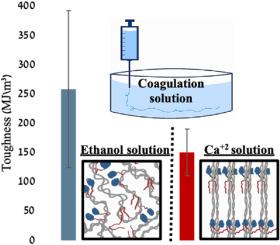Nanofilament organization in highly tough fibers based on lamin proteins
IF 3.3
2区 医学
Q2 ENGINEERING, BIOMEDICAL
Journal of the Mechanical Behavior of Biomedical Materials
Pub Date : 2024-09-16
DOI:10.1016/j.jmbbm.2024.106748
引用次数: 0
Abstract
The escalating plastic pollution crisis necessitates sustainable alternatives, and one promising solution involves replacing petroleum-based polymers with fibrous proteins. This study focused on the recombinant production of intracellular fibrous proteins, specifically Caenorhabditis elegans lamin (Ce-lamin). Ce-lamins spontaneously organize within the cell nucleus, forming a network of nanofilaments. This intricate structure serves as an active layer that responds dynamically to mechanical strain and stress. Herein, we investigated the arrangement of nanofilaments into nanofibrils within wet-spun Ce-lamin fibers using alcoholic solutions as coagulants. Our goal was to understand their structural and mechanical properties, particularly in comparison with those produced with solutions containing Ca+2 ions, which typically result in the formation of nanofibrils with a collagen-like pattern. The introduction of ethanol solutions significantly altered this pattern, likely through rearrangement of the nanofilaments. Nevertheless, the resulting fibers exhibited superior toughness and strain, outperforming various synthetic fibers. The significance of the nanofilament structure in enhancing fiber toughness was emphasized through both the secondary structure transition during stretching and the influence of the Q159K point mutation. This study improves our understanding of the structural and mechanical aspects of Ce-lamin fibers, paving the way for the development of eco-friendly and high-quality fibers suitable for various applications, including medical implants and composite materials.

基于层粘连蛋白的高韧性纤维中的纳米纤维组织
不断升级的塑料污染危机需要可持续的替代品,其中一个很有前景的解决方案就是用纤维蛋白替代石油基聚合物。这项研究的重点是细胞内纤维蛋白的重组生产,特别是秀丽隐杆线虫的层粘连蛋白(Ce-lamin)。Ce-层粘连蛋白在细胞核内自发组织,形成纳米纤丝网络。这种错综复杂的结构可作为活性层,对机械应变和应力做出动态响应。在此,我们使用酒精溶液作为凝固剂,研究了纳米纤丝在湿纺 Ce-lamin 纤维内排列成纳米纤丝的情况。我们的目标是了解它们的结构和机械特性,尤其是与含有 Ca+2 离子的溶液相比,后者通常会形成类似胶原蛋白模式的纳米纤维。乙醇溶液的引入极大地改变了这种形态,这可能是通过重新排列纳米纤丝实现的。尽管如此,由此产生的纤维仍表现出卓越的韧性和应变能力,优于各种合成纤维。通过拉伸过程中的二级结构转变和 Q159K 点突变的影响,强调了纳米纤丝结构在增强纤维韧性方面的重要性。这项研究增进了我们对 Ce-层状纤维的结构和力学方面的了解,为开发适用于医疗植入物和复合材料等各种应用的环保型高质量纤维铺平了道路。
本文章由计算机程序翻译,如有差异,请以英文原文为准。
求助全文
约1分钟内获得全文
求助全文
来源期刊

Journal of the Mechanical Behavior of Biomedical Materials
工程技术-材料科学:生物材料
CiteScore
7.20
自引率
7.70%
发文量
505
审稿时长
46 days
期刊介绍:
The Journal of the Mechanical Behavior of Biomedical Materials is concerned with the mechanical deformation, damage and failure under applied forces, of biological material (at the tissue, cellular and molecular levels) and of biomaterials, i.e. those materials which are designed to mimic or replace biological materials.
The primary focus of the journal is the synthesis of materials science, biology, and medical and dental science. Reports of fundamental scientific investigations are welcome, as are articles concerned with the practical application of materials in medical devices. Both experimental and theoretical work is of interest; theoretical papers will normally include comparison of predictions with experimental data, though we recognize that this may not always be appropriate. The journal also publishes technical notes concerned with emerging experimental or theoretical techniques, letters to the editor and, by invitation, review articles and papers describing existing techniques for the benefit of an interdisciplinary readership.
 求助内容:
求助内容: 应助结果提醒方式:
应助结果提醒方式:


